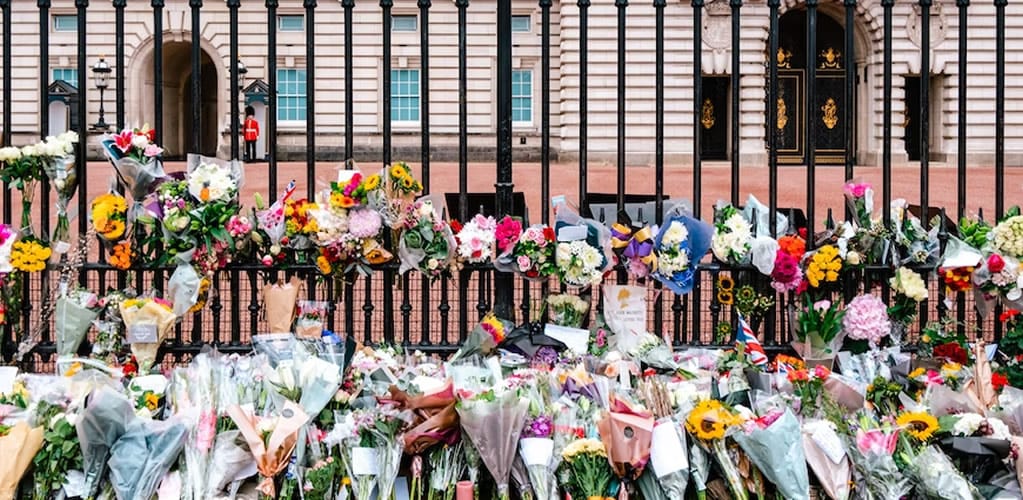What we mean when we say we are mourning Queen Elizabeth for the values she embodied
As words go, grief feels inadequate for describing public sentiment in the wake of the Queen’s death. More than the death of an individual, people are perhaps mourning the loss of what she represented.

As words go, grief feels inadequate for describing public sentiment in the wake of the Queen’s death. More than the death of an individual, people are perhaps mourning the loss of what she represented.
First published: Sept 2022.
The feeling and public expression of grief and sorrow following the death of Queen Elizabeth on September 8, 2022 has caught much of the British population off guard. It was inescapable that, at the age of 96, the Queen was nearing the end of her life. As retired palliative care doctor and author Kathryn Mannix tweeted, she had likely been dying for some time.
What can we learn from the death of the #Queen?
— Kathryn Mannix (@drkathrynmannix) September 11, 2022
The world has watched her live through the process of #OrdinaryDying, and yet dying went unspoken, un-named.
Let's notice what nobody mentioned: we all saw the Queen going through the stages of ordinary dying.
A 🧵...
1/ pic.twitter.com/5bYoZIXUvq
However, photographs of her meeting both the outgoing and incoming prime ministers just 48 hours prior meant that the announcement that she had died was unforeseen. Her passing is in that category of death in old age that end-of-life specialist Diana Teggi defines as expected but still sudden, and somewhat of a shock.
The coverage of the Queen’s death in the last week reflects how death is increasingly “spectacularised”, to use a term coined by death studies sociologist Michael Hviid Jacobsen.
We have seen blanket media coverage – on television, radio and online – of the extensive and highly choreographed pageantry involved in transporting the Queen’s coffin, with crowds of onlookers along the various routes, from Balmoral to Edinburgh, from Buckingham Palace to Westminster Hall. This serves to make of her death a spectacle. It creates a narrative of a national community of grief.
The question, though, is whether what we are seeing actually is a community of grief. Labelling the public response in this way simplifies what is a profoundly social event.
A collective reluctance to face up to death
There is a growing death-positive movement in the UK and around the world. It proposes the concept of death and grief literacy which champions talking about and preparing for death.
Rather than having dying be only the purview of the medical establishment, it frames death as a collective, social responsibility. The idea is that greater openness and greater compassion can increase collective well-being and a sense of community. It can make people feel less isolated in both their grief and facing up to their mortality.
Despite this, most deaths still remain abstracted from everyday life and hidden from view. As sociologist Tony Walter has put it:
As a result, actual, raw grief is still largely concealed too. It can be difficult to face up to and talk about openly, even for the monarchy.
Losing the Queen is likely, therefore, a significant moment in people’s lives as a very public, shared and visible reminder that you can be here one day and gone the next.
The Queen’s death as a societal loss
It is this shared quality of the Queen’s death that makes this national period of mourning so interesting and the term “grief” to describe public responses so inadequate. Only a handful of the British people actually public knew her as a person.
By all accounts, she had enduring relationships and was well-liked by her inner circle, as evidenced by the multitude of affectionate anecdotes that have been shared since she died. To those people, the impact of her death will be deeply felt.
But for others who did not know the Queen personally, more than the death of an individual, they are perhaps mourning the loss of what she represented. This has been seen in funerals for “ordinary” people, where it is not only the deceased individual who is being remembered but also the values and beliefs that they embodied.
These values in turn are expected to be reflected in the funerary rituals chosen by the organisers. A sign of a “good funeral” is when the values espoused in the funeral align with those of the individual who has died and the memories of those bearing witness to said ritual.
So far, this seems to be the case with the Queen. The respect being shown for her by people visiting makeshift shrines and filing past her coffin lying in state mirrors the esteem with which she was held in life and the values of reverence and resilience that she personified.
Such sentiment has been echoed in countless news articles, opinion pieces, statements from politicians and interviews with people on the street, where time and again it has been recognised that the Queen was a unique individual worthy of such attention and public response.
Over 70 years her behaviour and apparent value system was absolutely consistent, with commentaries reflecting on her humility, tolerance, discretion, pragmatism, graciousness and sense of civic duty. The sadness being expressed by those mourning in public then becomes about not just the loss of her as an individual but also the way she conducted herself and the values she embodied.
Why we have ritual
Much like attending a funeral but taking part on a much grander scale, participating in the public mourning for the Queen – standing on the pavement to watch the coffin cortege pass, waiting in the queue to pay one’s respects – is thus about bearing witness to this loss together. In his analysis of where people went to mourn the death of Princess Diana in 1997, sociologist Tony Walter describes the rare sense of solidarity these mourners experienced.
In mourning Diana, much like in remembering the war dead on Remembrance Sunday, a sense of society – of togetherness with others people did not know personally – was constructed. For everyday people, this is typically the purpose of a funeral service, to come together and feel a sense of community in remembering the deceased.
Such rituals of remembrance, whether highly or orchestrated or spontaneous, have a restorative and social function after a significant event. Rather than being simply about the expression of grief, it is this social function that we are observing right now in the public mourning for Queen Elizabeth, as we mourn the loss of what she represented.


|

|

|
— AUTHOR —

|
▫ Dr Kate Woodthorpe, Reader in Sociology, University of Bath. |
Sources
- Text: This piece was originally published in The Conversation and re-published in PMP Magazine on 18 September 2022. | The author writes in a personal capacity.
- Cover: Unsplash/Samuel Regan-Asante. - Buckingham Palace. (Licensed under a Creative Commons Attribution-ShareAlike 4.0 International License.)







[Read our Comments Guidelines]